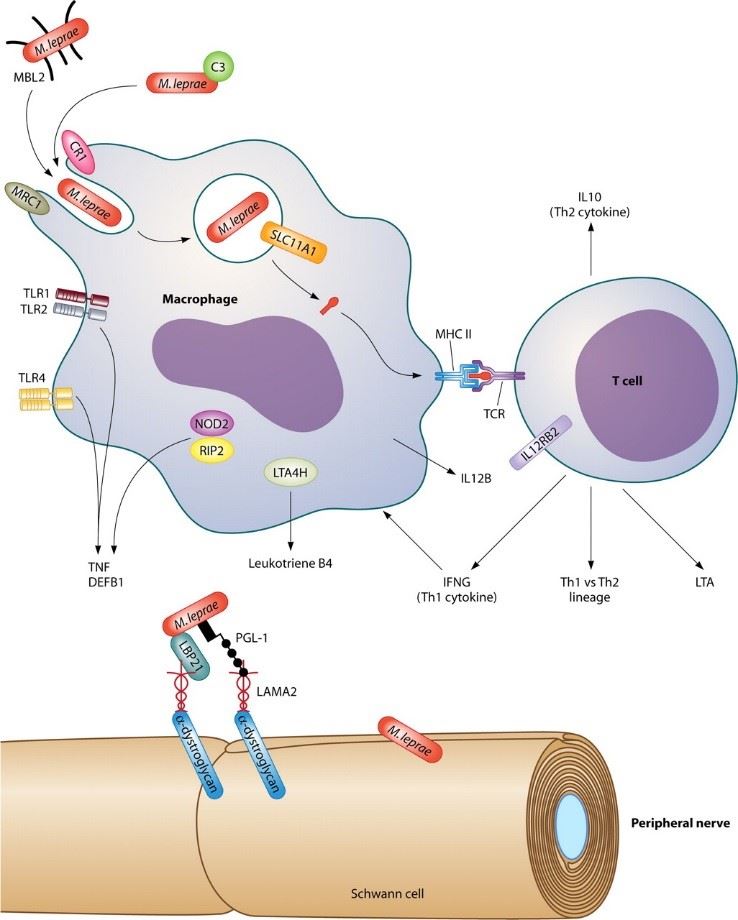SLC11A1 (formerly Nramp1) plays a very important role in macrophage (mf) activation, including regulation of the CXC chemokine KC, interleukin-1b (IL-1b), inducible nitric oxide synthase (iNOS), major histocompatibility complex (MHC) class II molecules, tumour necrosis factor a (TNFa), nitric oxide (NO) release, L-arginine flux, oxidative burst and tumoricidal as well as antimicrobial activity. In human, SLC11A1 is always associated with multiple infectious and autoimmune diseases. The infectious diseases include viral (HIV), bacterial (tuberculosis, leprosy, meningococcal meningitis) and protozoan (visceral leishmaniasis) pathogens. Both SLC11A1 and SLC11A2 have protein kinase C (PKC) binding sites, but only SLC11A1 has a Pro±Ser-rich N-terminus.
| Basic Information of SLC11A1 | |
| Protein Name | Natural resistance-associated macrophage protein 1 |
| Gene Name | SLC11A1 |
| Aliases | Solute carrier family 11 member 1 |
| Organism | Homo sapiens (Human) |
| UniProt ID | P49279 |
| Transmembrane Times | 12 |
| Length (aa) | 550 |
| Sequence | MTGDKGPQRLSGSSYGSISSPTSPTSPGPQQAPPRETYLSEKIPIPDTKPGTFSLRKLWAFTGPGFLMSIAFLDPGNIESDLQAGAVAGFKLLWVLLWATVLGLLCQRLAARLGVVTGKDLGEVCHLYYPKVPRTVLWLTIELAIVGSDMQEVIGTAIAFNLLSAGRIPLWGGVLITIVDTFFFLFLDNYGLRKLEAFFGLLITIMALTFGYEYVVARPEQGALLRGLFLPSCPGCGHPELLQAVGIVGAIIMPHNIYLHSALVKSREIDRARRADIREANMYFLIEATIALSVSFIINLFVMAVFGQAFYQKTNQAAFNICANSSLHDYAKIFPMNNATVAVDIYQGGVILGCLFGPAALYIWAIGLLAAGQSSTMTGTYAGQFVMEGFLRLRWSRFARVLLTRSCAILPTVLVAVFRDLRDLSGLNDLLNVLQSLLLPFAVLPILTFTSMPTLMQEFANGLLNKVVTSSIMVLVCAINLYFVVSYLPSLPHPAYFGLAALLAAAYLGLSTYLVWTCCLAHGATFLAHSSHHHFLYGLLEEDQKGETSG |
SLC11A1, a multi-pass membrane protein, is a member of the solute carrier family 11. The protein participates in divalent transition metal (iron and manganese) transporting which is involved in iron metabolism and bring about resistance to certain pathogens. Mutations of this gene are always companied with many infectious diseases like tuberculosis and leprosy, and inflammatory diseases like rheumatoid arthritis and Crohn's disease. Spliced variants encoded different protein isoforms have been found out but only one of them has a clear full-length nature.
 Fig1. Genes and gene products involved in the immune response to M. leprae. (Misch, 2010)
Fig1. Genes and gene products involved in the immune response to M. leprae. (Misch, 2010)
This article shows Nramp1 plays a role in phagocyte defenses against infections.
This article reviews the recent researches related to the Slc11a1 function in iron metabolism and iron recycling in macrophages, the association between SLC11A1 and human disease, and the utilization of mouse breeding and introgression of knockouts onto Slc11a1 congenic backgrounds for genes encoding the multiple pleiotropic functions.
This article shows that there is no statistically significant association between the SLC11A1 variants (3'UTR, D543N, INT4 and 5'(GT)n loci allele variants) and susceptibility to tuberculosis (TB) in a group of European descent, but the presence of a statistically significant association in Asian subjects (except the INT4 variant), African subjects (except the 3'UTR variant) and the population as a whole.
In this article, authors examined polymorphisms at SLC11A1 in 59 multicase families of visceral leishmaniasis (VL) from the high-incidence Masalit tribe in Sudan. Results show no new putative functional polymorphisms in the coding region, intron 1, intron/exon boundaries, intron 4/exon 4a, or in the 3'UTR are identified in 36 individuals fails. While a novel promoter polymorphism (-86G/A), located within a putative nuclear factor kappa B binding site, could be functional.
Membrane protein studies have got great progress over the past few years. Based on our versatile Magic™ membrane protein production platform, we can provide a series of membrane protein preparation services in reconstitution forms as well as multiple active formats for worldwide customers. Besides, aided by our versatile Magic™ anti-membrane protein antibody discovery platform, we also provide customized anti-SLC11A1 antibody development services.
During the past years, Creative Biolabs has successfully generated many functional membrane proteins for our global customers. It’s our pleasure to boost the development of our clients’ programs with our one-stop, custom-oriented service. For more detailed information, please feel free to contact us.
Reference
All listed services and products are For Research Use Only. Do Not use in any diagnostic or therapeutic applications.